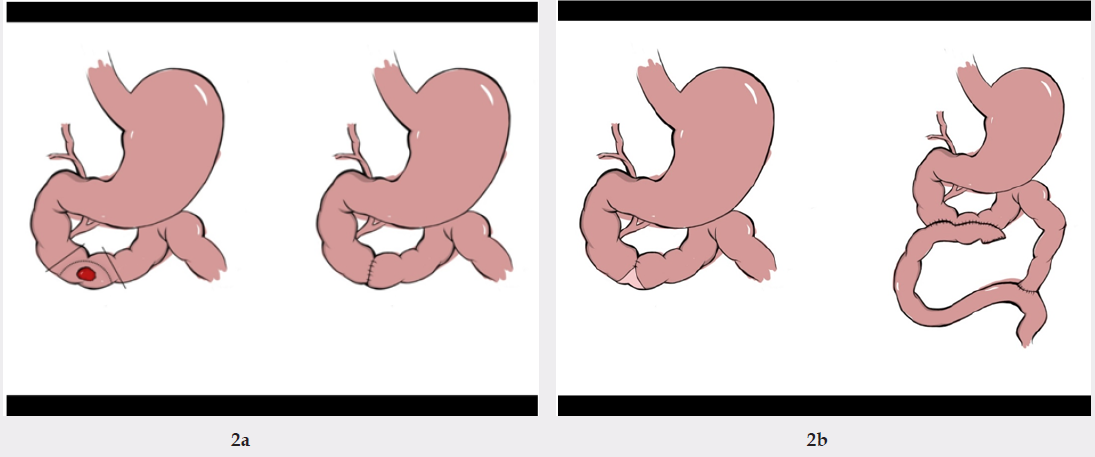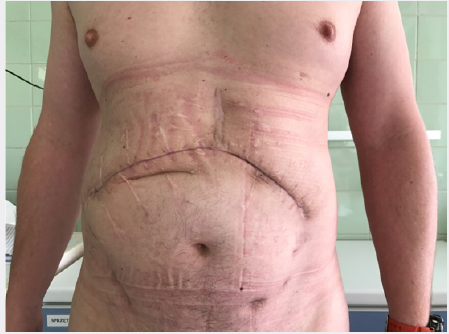
Lupine Publishers Group
Lupine Publishers
Menu
ISSN: 2641-1652
Case Report(ISSN: 2641-1652) 
Successful Endoscopic Treatment of Refractory Postoperative Duodenocutaneous Fistula using Fibrin Sealant Volume 1 - Issue 2
Adam Dmitruk1, Anna Pietrzak*1,2, Maciej Rupinski,2, Lukasz Zyskowski1 and Tomasz Olesinski1
- 1 Maria Sklodowska-Curie Memorial Cancer Center, Institute of Oncology, Warsaw, Poland
- 2Department of Gastroenterology, Hepatology and Clinical Oncology, Medical Centre for Postgraduate Education, Warsaw, Poland
Received: July 02, 2018; Published: July 09, 2018
*Corresponding author: Anna Pietrzak, Roentgen 5 Str, 02-781 Warsaw, Poland
DOI: 10.32474/CTGH.2018.01.000109
Case Report
Iatrogenic, postoperative enteroatmospheric fistulas remain difficult to manage but common problem after gastrointestinal surgery. Surgical revision, after failure of conservative treatment is not only partially efficient but also carries a high mortality risk, mainly due to patients’ general condition and usually multiples comorbidities. Because of that alternative minimally invasive techniques are extensively studied, but unfortunately the data are still confounding [1,2]. We present a case of 38 – y.o. man with past history of nephrolithiasis, accidentally diagnosed with 30 mm gastrointestinal stromal tumour of the duodenum (Figures 1a-1c).
Figure 1a: Contrast enhanced multidetector multiphase computed tomography of the abdomen and pelvis showing solid tumor (Ø 30 mm) between duodenum and pancreas (cross-section) (arrow).
Figure 1b: Contrast enhanced multidetector multiphase computed tomography of the abdomen and pelvis showing solid tumor (Ø 30 mm) between duodenum and pancreas (anterior-posterior section) (arrow).
Figure 1c: Contrast enhanced multidetector multiphase computed tomography of the abdomen and pelvis showing solid tumor (Ø 30 mm) between duodenum and pancreas (latteral-section) (arrow).

Tumour resection with end-to-end anastomosis of transversal duodenum was performed, but the procedure was complicated by massive intraabdominal bleeding leading to acute pancreatitis and finally to enterocutaneous fistula forming. In course of treatment, the patient required five reoperations with Roux-en-Y resection and sewing patch on the fistula’s enteral orifice, but no one was efficient (Figures 2a& 2b). To avoid another reoperation we decided to perform endoscopic fistula closure by injection fibrin glue (Tisseel, Baxter) into the internal opening (Figures 3a-3c). Procedure was performed via catheter using standard Olympus videoendoscope. We observed immediate fistula closing, and there were no early nor late complications related to the procedure. Patient was discharged after 67 days of hospital stay. After 11 months of follow-up patient remains cured (Figure 4). In conclusion, the fibrin sealant treatment is safer and much less invasive viable option, and it should be taken into account in selected cases [3].It appears that fistula closure is more efficient if performed from the internal opening.
Figure 2a: Tumor of the duodenum and preformed resection scheme.
Figure 2b: Contrast enhanced multidetector multiphase computed tomography of the abdomen and pelvis showing solid tumor (Ø 30 mm) between duodenum and pancreas (anterior-posterior section) (arrow).

Figure 3a: Internal opening of duodenocutaneous fistula with catheter.
Figure 3b: Administration of fibrin sealant via catheter.
Figure 3c: Immediate fistula closing.

References
- Galie K, Whitlow Cg (2006) Postoperative enterocutaneous fistula: when to reoperate and how to succeed. Clin Colon Rectal Surg 19(4): 237-246.
- Kumar N, Larsen MC, Thompson CC (2014) Endoscopic management of gastrointestinal fistulae. Gastrenterol Hepatol 10(8): 495-452.
- Lippert E, Klebl FH, Schweller F (2011) Fibrin glue in the endoscopic treatment of fistulae and anastomotic leakages of the gastrointestinal tract. Int J Colorectal Dis 26(3): 303-311.

Top Editors
-

Mark E Smith
Bio chemistry
University of Texas Medical Branch, USA -

Lawrence A Presley
Department of Criminal Justice
Liberty University, USA -

Thomas W Miller
Department of Psychiatry
University of Kentucky, USA -

Gjumrakch Aliev
Department of Medicine
Gally International Biomedical Research & Consulting LLC, USA -

Christopher Bryant
Department of Urbanisation and Agricultural
Montreal university, USA -

Robert William Frare
Oral & Maxillofacial Pathology
New York University, USA -

Rudolph Modesto Navari
Gastroenterology and Hepatology
University of Alabama, UK -

Andrew Hague
Department of Medicine
Universities of Bradford, UK -

George Gregory Buttigieg
Maltese College of Obstetrics and Gynaecology, Europe -

Chen-Hsiung Yeh
Oncology
Circulogene Theranostics, England -
.png)
Emilio Bucio-Carrillo
Radiation Chemistry
National University of Mexico, USA -
.jpg)
Casey J Grenier
Analytical Chemistry
Wentworth Institute of Technology, USA -
Hany Atalah
Minimally Invasive Surgery
Mercer University school of Medicine, USA -

Abu-Hussein Muhamad
Pediatric Dentistry
University of Athens , Greece

The annual scholar awards from Lupine Publishers honor a selected number Read More...









